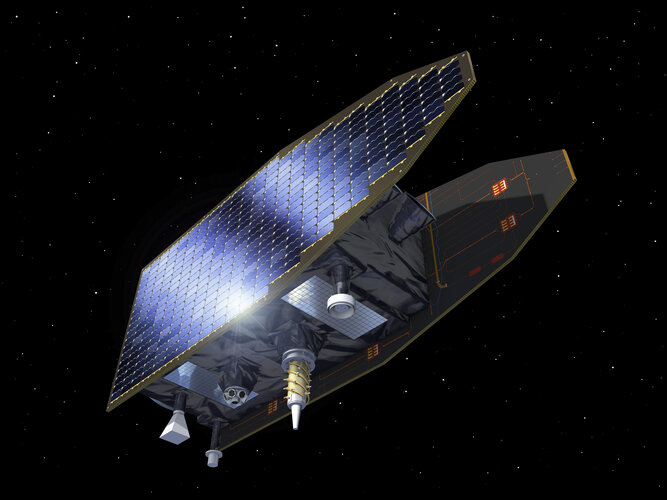
Copernical Team
DORIS joins ESA’s Genesis mission

The second Genesis Science Workshop, held on 3 and 4 April in Matera, Italy, brought together the ESA Genesis team, industry experts and scientists from the international community to discuss the mission’s progress, including the latest satellite design evolutions, and prepare for the most extensive science exploitation possible. ESA and the French Space Agency CNES signed a contract during the event, confirming that the fourth geodetic technique, DORIS, will join the mission.
New ESA invention tested in a chamber of no echoes
 Image:
New ESA invention tested in a chamber of no echoes
Image:
New ESA invention tested in a chamber of no echoes New observations show the asteroid that won't hit Earth resembles a spinning hockey puck
This request seems a bit unusual, so we need to confirm that you're human. Please press and hold the button until it turns completely green. Thank you for your cooperation!
Press and hold the button
If you believe this is an error, please contact our support team.
185.132.36.159 : f0da628c-6d5c-4848-83dc-1cec91a3
A micromoon will grace the night skies this weekend
This request seems a bit unusual, so we need to confirm that you're human. Please press and hold the button until it turns completely green. Thank you for your cooperation!
Press and hold the button
If you believe this is an error, please contact our support team.
185.132.36.159 : 9cc433a2-cc43-4bf7-9495-c4bdc30f
P160C solid-propellant rocket motor rolls out to its test stand
 Image:
P160C solid-propellant rocket motor rolls out to its test stand
Image:
P160C solid-propellant rocket motor rolls out to its test stand In Alabama, NASA's annual rover vehicle challenge drives inspiration for moon, beyond
 NASA will kick off its 31st annual Rover Competition this week in Alabama, giving students from around the world a chance to show their engineering prowess in the space agency's " obstacle course games.
On Friday, student teams will gather for NASA's annual Human Exploration Rover Challenge near the Marshall Space Flight Center in Huntsville to compete at the U.S. Space & Rocket Cen
NASA will kick off its 31st annual Rover Competition this week in Alabama, giving students from around the world a chance to show their engineering prowess in the space agency's " obstacle course games.
On Friday, student teams will gather for NASA's annual Human Exploration Rover Challenge near the Marshall Space Flight Center in Huntsville to compete at the U.S. Space & Rocket Cen NASA to livestream Senate confirmation hearing for Trump's nominee to lead space agency
 NASA announced Monday it will livestream the Senate confirmation hearing of President Donald Trump's nominee to lead America's space agency.
On Wednesday, Jared Isaacman is slated to sit down in front of lawmakers at 10 a.m. EDT inside the Russell Building before the Senate's Committee on Commerce, Science and Transportation as the panel considers Isaacman to be the next NASA administra
NASA announced Monday it will livestream the Senate confirmation hearing of President Donald Trump's nominee to lead America's space agency.
On Wednesday, Jared Isaacman is slated to sit down in front of lawmakers at 10 a.m. EDT inside the Russell Building before the Senate's Committee on Commerce, Science and Transportation as the panel considers Isaacman to be the next NASA administra NASA astronaut Jonny Kim, two cosmonauts dock with ISS
 A Soyuz rocket with NASA astronaut Jonny Kim and two Russian cosmonauts on board docked with the International Space Station early Tuesday, following a three-hour, 10-minute flight from launch in Kazakhstan.
Capture between the rocket and the orbiting space laboratory was confirmed at 4:57 a.m. EDT over western Russian.
The spacecraft with its three crew members on board launched
A Soyuz rocket with NASA astronaut Jonny Kim and two Russian cosmonauts on board docked with the International Space Station early Tuesday, following a three-hour, 10-minute flight from launch in Kazakhstan.
Capture between the rocket and the orbiting space laboratory was confirmed at 4:57 a.m. EDT over western Russian.
The spacecraft with its three crew members on board launched Weather satellite operational, completes fleet to forecast severe storms on Earth
 The final piece of an advanced series of weather satellites officially began operating Tuesday to help provide better forecasts on Earth and in space, according to the National Oceanic and Atmospheric Administration.
GOES-19 satellite replaces GOES-16 to cover the GOES East orbit 22,236 miles above Earth's equator. It also completes NOAA's Geostationary Operational Environmental Satelli
The final piece of an advanced series of weather satellites officially began operating Tuesday to help provide better forecasts on Earth and in space, according to the National Oceanic and Atmospheric Administration.
GOES-19 satellite replaces GOES-16 to cover the GOES East orbit 22,236 miles above Earth's equator. It also completes NOAA's Geostationary Operational Environmental Satelli Martian rock on the move

This new snapshot from the European Space Agency’s Mars Express deftly captures the two distinct faces of Mars: ridged and rugged versus smooth and unmarked.

